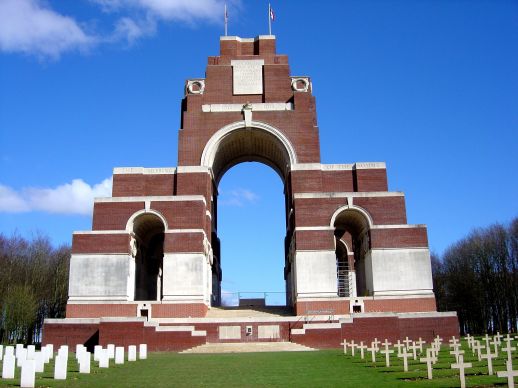Charles Hopewell
Date of birth: 1897
Date of death: 10.3.1917
Area: Kirkhamgate
Regiment: King’s Own Yorkshire Light Infantry
Family information: Son of Mrs Hopewell of Engine Fold, Kirkhamgate
Rank: Private
Service number: 201409
War Service
There were two C Hopewell’s killed in 1917 but a letter exists from John William Wilsher of the King’s Own Yorkshire Light Infantry 2nd/4th Battalion that mentions the death of his colleague and friend Charlie Hopewell, so we know the name on the memorial refers to the one in the KOYLI. He was a coal miner and worked at Wrenthorpe Colliery as he is remembered on the Wrenthorpe Colliery Memorial in St John’s Churchyard, Wakefield.
He enlisted at Wakefield as Private 201409 of the KOYLI 2nd/4th Battalion and was killed in action on 10th March 1917. He is remembered on the Thiepval Memorial.
Charles was a bit of a puzzle until I found an article in the Wakefield Express which spoke of Mrs Hopewell of Engine Fold, Kirkhamgate having been told of the sad news of the death of her only son, John Charles Hopewell, at the same time as news that her husband, who was serving in the same battalion as Charles, had been injured and was in a Liverpool hospital. I found that her husband Allan George Hopewell was only about 31 and Charles was 18 which led me to believe that Charles was not the product of that marriage but had taken his step father’s name. Indeed, I found that he had been born John Charles Brown to his mother Phyllis who had later married Allan at St Paul’s, Alverthorpe in 1912. This was confirmed by a note on Army records of soldiers’ effects stating “Charles Hopewell alias Brown.” Both Phyllis and Allan had previously been widowed and the wedding certificate states that Phyllis was 10 years older than Allan.
The paper also quoted an army captain who wrote to Phyllis saying “Your son has been a member of my company for two years. He was always a good soldier and one I could ill afford to lose.”
Another officer had also written to her saying that Charles had been one of a party who had occasion to help the guns when they were caught by shell fire. “He was a very nice boy and I am very deeply grieved at his death. He was buried at night and the service was very impressive. I hope you will take some comfort from the fact that he died doing his duty as a gallant Englishman.”
This account is confirmed by the official war diary for the 2/4th KOYLI which states that on the 10th March the battalion were resting in billets in Miraumont when a party were sent from A Company “to help to move damaged guns”. It goes on to state that this party “were caught by shell fire, several casualties occurring.” In the 12 hours from 12 noon on 10th they had lost 6 men and 11 wounded.
Charles’ stepfather had written to his wife telling her that his steel helmet had saved his life. He said everything possible had been done for Charles and that he had been at his funeral.
Charles had enlisted on November 25th 1915 aged just 18 years, previous to which he had been a fireman at Newton Colliery. The obituary in the paper went on to say that he had been an “orderly to one of the officers – a Wakefield gentleman – and was held in very high esteem.” He was awarded the British War Medal and the Victory Medal.
His father recovered from his wounds and was discharged from the army in February 1919.
 Thiepval Memorial
Thiepval Memorial

